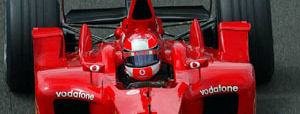Chimney or Funnel
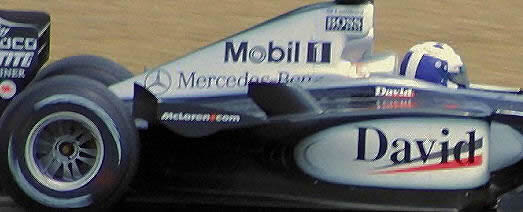
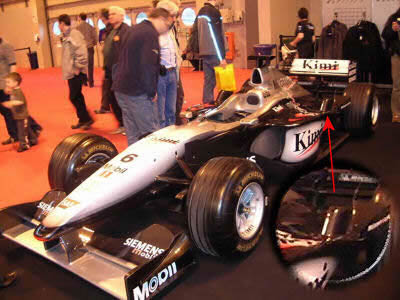
Chimney at McLaren MP4-14
Another remarkable appearance was invented by McLaren. The "chimneys" or "funnels" in front of the rear wheels do not put out engine exhaust gasses, but rather hot air from radiators. Some other teams have copied this novelty in 2001. The principle behind this is actually very simple. Point is to direct air flow either side of the rear wing and as the outlets was above the main flow passing close to the sidepods surface, the outlet wouldn't change cars aerodynamics so much. Additionally the outlet further forward allowed the sidepods to be narrower between the rear wheels.
This solution has become known as a chimney and has been adopted by almost all the teams at some point, either as a permanent fixture or as an aid to improve the cars cooling requirements in certain situations and circuits.
On the one hand, the air passing through the radiators isn't specified by the throttle, but it depends on the car speed. Increasing the throttle makes the engine suck move air into it, and thus generates more exhaust gasses. Radiators are only provided by air flowing in trough sidepods, due to the movement of the car. So the effect of engine exhausts is just that little faster on downforce in acceleration then with radiator air. On the other hand, it is very interesting of blowing out this hot air as soon as possible, because it heats up the inside of the car and engine surroundings. Keeping the air longer under the bonnet, will increase the engine temperature.
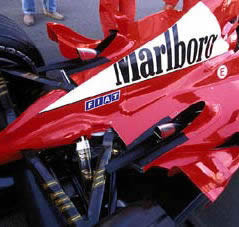 |
 |
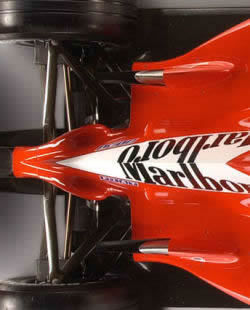 |
|
Ferrari f2002 chimney with exhaust |
Year is 2002 and Ferrari on his car, f2002, made use of a aerodynamic effect that used the very fast flow from the exhaust pipe to accelerate cooling flow through a chimney duct, effectively acting as a pump to scavenge hot air form the sidepods. This is accomplished by creating a pressure gradient and venturi effect, a phenomenon sometimes referred to as 'aspiration'. The increase in speed of the air over the chimney creates a low-pressure region that sucks out air from the sidepods to aid the radiators in cooling the engine. The distinctive tall arched outlets around the sidepods became adopted by others again both as permanent and optional cooling solutions.
This concept was studied by Parra and Kontis in their 2006 paper, Aerodynamic effectiveness of the flow of exhaust gases in a generic formula one car configuration, published in the The Aeronautical Journal:
"Due to the characteristic configuration of a Formula One car, the exhaust pipes pass through the chamber located directly behind the radiators. This chamber is normally shaped so that it enhances the outflow of gases. However, an extra outflow could be generated by inserting the exhaust pipe into a bigger diameter duct to create a mixing stream. Such mixing is believed to generate an aspiration along the outer duct, based on the same principles of operation as an ejector pump. Because this enveloping duct connects the chamber behind the radiator with the atmosphere, an outflow of gases through this passage would increase the efficiency of the radiator," (p574).
The downside of this solution was that both the exhaust and cooling flows went directly into the rear wing, hindering its efficiency. Hot air is not as dense as cold air, diminishing wing effectiveness.
Second problem was very hot air blowing over the wing. We are talking here of temperature of few hundred degrees Celsius. Special shielding was required to protect carbon fiber material. You can see this protections applied on upper suspension wishbone in gold color in the pictures above.
Third problem was different air speed over the wing, depending on throttle.
But gain using this solution was bigger. Coke bottle area now can be tighter, and this greatly improves air flow on the back of the car.
Allied to the Exhaust fairing outlet Ferrari placed the radiators at a compound angle in the sidepods. Usually the radiators are angled in one dimension vertically or horizontally, usually placing both oil and water cores into a single panel. By angling the radiator in such a way Ferrari were able to increase the size of the radiators surface area (area of panel is more important to cooling than the thickness of the core) without making larger sidepods. Again, now every team uses radiators at a compound angle in the sidepods.
As a result of the changes the 2009 cars appear quite different to their predecessors, with the removal of the vast majority of bargeboards, winglets, chimneys and cooling gills leading to much cleaner looking designs. Gone are the fairings on the front suspension pick-up points (where the suspension attaches to the monocoque) and the use of turning vanes is now restricted to a small triangular section in front of the sidepods. Cooling vents, chimneys and winglets are noticeably absent from the top of the sidepods and there is no winglets on top of the rear axle.

